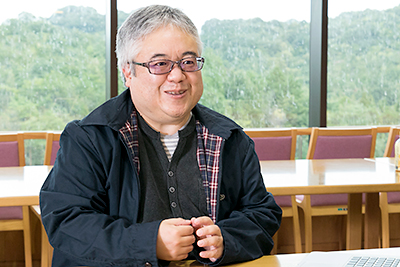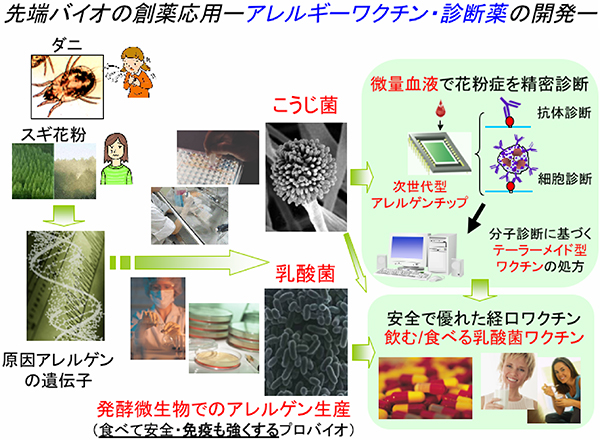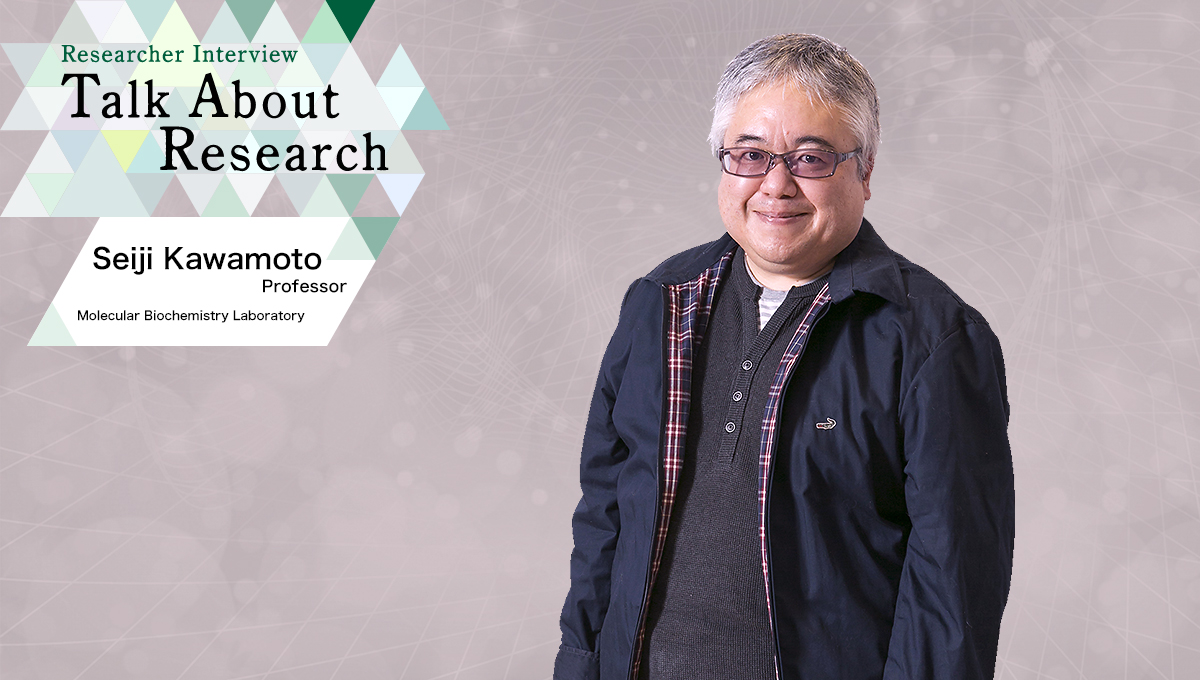Developing tailor-made vaccinations to eradicate allergies
Prof. Kawamoto’s research is in the branch of biotechnology that aims to protect people’s health. It centers on three major pillars, namely, allergy, food, and immunity.
First of all, let’s take a look at the first pillar: allergy.
Many people suffer from allergies. In Japan, it is said that one in two people suffers from Japanese cedar pollinosis or dust mite-triggered rhinitis, bronchial asthma, or atopic dermatitis. Focusing on these ailments, Prof. Kawamoto and his research group examined in detail the allergens (substances that trigger allergic reactions) of Japanese cedar pollinosis and dust mite-caused allergies, respectively, successfully elucidating their entire mechanisms. As a result, the group now owns Japan’s only “allergen library,” which is also considered one of the best in the world.

Prof. Kawamoto says, “In our research, we discovered that different persons develop the same allergy to dust mites in reaction to different allergens. This is significant for the treatment of allergies. Sublingual immunotherapy(※1) is a treatment method often used today. If the medicine used in this therapy contains allergen extract ‘A,’ and if you don’t react to it but react to allergen ‘B,’ then the therapy doesn’t work, and you won’t get better. So we think it’s better to check beforehand to which allergen each patient reacts and change vaccine molecules to use in the drugs to administer individually. The research trend in the world has progressed this far.”
Prof. Kawamoto explains that identifying different allergens that cause allergies in individuals will open up the path to tailor-made healthcare.
“If we can identify each patient’s trigger allergen, we can develop and administer a medicine accordingly. Healthcare provided in such a personalized manner for each patient is called ‘tailor-made healthcare.’ As one form of tailor-made healthcare, we’re trying to develop tailor-made allergen extract-based vaccines.”
- ※1:Sublingual immunotherapy: Therapy for allergies in which every day a patient places an oral medicine containing an allergen under the tongue for a while before swallowing it to gradually develop immunity to the allergen
 Pathogenesis of an allergy and therapies
Pathogenesis of an allergy and therapies
Drawing on its original allergen library, Prof. Kawamoto’s research group is developing a next-generation allergy molecule diagnostic system that can identify trigger allergens of individual persons. The group is also working to develop brand new anti-allergy vaccines.
Prof. Kawamoto says, “There are over 100 allergens in Japanese cedar pollens. When allergens enter the human body, they bind with IgE antibodies(※2) and cause an allergic reaction. Since an allergen is a protein, it is coded in genes. So we generated lactic acid bacteria carrying cedar pollen allergen genes. We confirmed in animal tests that drinking the lactic acid bacteria before being exposed to cedar pollens can prevent the onset of pollinosis. We have created a vaccination against cedar pollen allergy with a familiar fermented microorganism.”
- ※2:IgE antibodies: Antibodies that react to allergens, such as dust mites and pollens, and trigger an allergic reaction
 Developing a next-generation allergy molecule diagnostic system
Developing a next-generation allergy molecule diagnostic systemand therapeutic technologies (graphic summary)
Working toward the treatment of presymptomatic diseases with
foodstuffs and discovering a new immunosuppressive antibody
Prof. Kawamoto’s research on allergies has developed into the development of foodstuffs.
“Our research area, bioengineering, is characterized by the fact that researchers are always considering possible application to manufacturing. When we were working on allergy vaccinations, we turned to the shapes of foodstuffs to come up with ideas for medicines that could be orally administered with ease, unlike conventional medicines and injections.”
This is how Prof. Kawamoto’s group began research around the second pillar, i.e., food. The scientists of his group are now also working on the development of functional foodstuffs that can be consumed daily to prevent disease.
Prof. Kawamoto explains one of the research themes:
“Red perilla is a familiar food ingredient for us Japanese. It’s used to give the red color to pickled ume and used in dried toppings for cooked rice, for example. It also has a less known status as a medicinal herb used in traditional Chinese medicine. We carried out an experiment in which we let model mice with atopic dermatitis freely eat food with a 5% red perilla content. We confirmed that this diet dramatically inhibited the progress of the mice’s dermatitis. We identified a new anti-allergic compound that’s responsible for this effect of red perilla and examined its mechanism of action. To our surprise, we were able to discover that this compound suppresses the allergic reaction by acting on the molecule that plays an important role in cancerization. From allergy to cancer!
It was totally unexpected. At present, we are beginning to understand that this compound in red perilla has an excellent anti-cancer action, turning on the ‘switch’ of the cancer control gene innate in our body. We are conducting such research jointly with our corporate partners. In this research group, you can be in the forefront of R&D, incomparable to what you would normally experience in an internship at a company as part of your job search. Graduates from this group, with readily deployable capabilities, are now actively working in various sectors as researchers and technicians.”


Regarding the potential of food research, that is, the development of foodstuffs that can prevent disease based on similar findings, Prof. Kawamoto explains as follows:
“Perhaps from the middle of the twenty-first century, the majority of people in society will be quite old. In such a society, it wouldn’t work if all persons feeling unwell or getting sick just went to medical institutions. Then the current health insurance system might collapse. So I think for the future we will have to change the way we operate and realize a society where people don’t have to seek medical attention in the first place. To do that, one key is food. That’s why we are carrying out research to find food ingredients that effectively prevent diseases so that they could replace healthcare, so to speak.”
Prof. Kawamoto’s research of this kind is intended to develop foodstuffs that prevent not only allergies but also cancers, dementia, and other diseases associated with advanced age.
 Experiment using model mice
Experiment using model micein which atopic dermatitis appears spontaneously
The third pillar of research is immunity.
Prof. Kawamoto says, “Because of the COVID-19 pandemic, immunity and the development of vaccines are being much talked about today. Vaccination is a way of protecting our body by taking advantage of the innate immune mechanism of the human body. When a vaccine enters the body, Y-shaped proteins, antibodies, are generated and trigger protective actions against infection, capturing the virus or inducing white blood cells to attack virus-infected and weakening cells. We discovered that in this system, there is an antibody that acts on white blood cells like brakes to keep inflammation from becoming excessive.”
The regulatory antibody that the Kawamoto group discovered suppresses diseases that are mainly caused by a cytokine storm, i.e., an uncontrolled immune response.
Prof. Kawamoto continues, “We have demonstrated that our antibody is effective in controlling some severe diseases for which there is no cure at the moment, such as fulminant hepatitis and acute respiratory distress syndrome (ARDS).”
In his laboratory, the antibody was administered to model mice with ARDS.
“We can generate model mice that represent the terminal stage of a severe case of COVID-19. That’s the kind of condition in which death is certain for all mice within 24 h following induction. But in our experiment, we were able to maintain high survival rates by administering the antibody.” This outstanding research achievement is expected to lead to a significant application in the control of an excessive immune response.
“To be honest, we still don’t know exactly how this antibody works. Once we find this out clearly, I think this could be effectively applied to controlling a range of diseases. Since diseases caused by chronic inflammation, which torment many elderly people, are caused by an excessive immune response, we can expect a broad scope of application.”
Active in joint research through HiHA,
embracing the personal research policy of looking squarely at results
It is impossible to introduce the research of Prof. Kawamoto’s without mentioning his activity as the director of the Hiroshima Research Center for Healthy Aging (HiHA). HiHA was selected by Hiroshima University in 2013 as an incubation research center capable of conducting research activities at the world’s highest level. At present, HiHA is a representative standalone research center attached to Hiroshima University, actively promoting research on two main themes, “molecules and life” and “medicine and food.”
Prof. Kawamoto says, “At HiHA, researchers in the health and biotechnology group in the Bioengineering Program play the central role. We have researchers in medical sciences and other branches of life sciences within Hiroshima University join us in pursuing a variety of research programs.”
He also says that another major characteristic of HiHA is that its main activity is joint research with other Japanese universities and overseas research centers. Prof. Kawamoto himself spent a few years doing research at the Harvard Medical School. Other scientists who belong to HiHA have regularly been going abroad for research, continuing the center’s international collaboration.
Prof. Kawamoto says, “Instead of simply extending people’s longevity, it would be ideal to enable people to live long in good health and, when the time comes, depart naturally and peacefully, living out their natural life span. But in reality, many people spend the last 10 years or so of their lives in extremely difficult conditions, requiring caregivers’ help. So I think it’s necessary for HiHA to tackle the question of how to maintain people in good health for a long time in its research. The research we’re already conducting toward the goal of physical and mental health through daily diet without medical care stems from exactly the same desire for healthy longevity.”
 At Harvard (with a research partner)
At Harvard (with a research partner)
As for his attitude toward research, he attaches great importance to looking squarely at results that come out, no matter what.
“We design and conduct an experiment, hypothesizing the results and assuming that it would go this way or that way. But it’s not unusual that your experiment fails and you get results that make no sense to you. In such a case, instead of frankly writing them off as flops, I think it’s important to examine the results attentively. This way you might arrive at a totally unexpected discovery. You must squarely come face to face with what is happening right before your eyes, and not constrain yourself with your preconceived ideas. Such an attitude can lead to something new out of the blue.”
Indeed, the discovery of the antibody mentioned above resulted from the detection of a mistake in an experiment when the research group was requested to redo the experiment to look into the properties of a substance. “We said to ourselves, ‘There must be something unknown to us,’ and embarked on a search for it. Then, something completely new came about. I think this example shows the importance of facing any research results as they are while believing in your insight.”
Prof. Kawamoto studied chemical engineering for food production as an undergraduate and animal cell engineering and antibody engineering as a graduate student. He continued his research at Harvard in a research unit of allergy and immunology specialists. While expanding his learning and networking, making diverse contacts, he has come to engage in cutting-edge research in an area where many disciplines crisscross. Yet he says he is not quite sure exactly how all this has transpired.
“Anyway, I can at least say that all the studies I have done and the people I have met have somehow led me to the research I’m doing right now. Thinking about this, I would love to welcome to my laboratory all willing students, regardless of their current majors. I’d like to urge especially those who want to work in pharmaceutical or food industries later to consider joining us. In this laboratory, research areas are quite straightforward, and you can experience research in a whole range of fields that serve people, from basic and applied research. I think it’s a place where you can have a series of interesting experiences in manufacturing-oriented biotechnology on the solid foundation of basic research, naturally expanding it to application.”
 Opened on October 20, 2021
Opened on October 20, 2021


